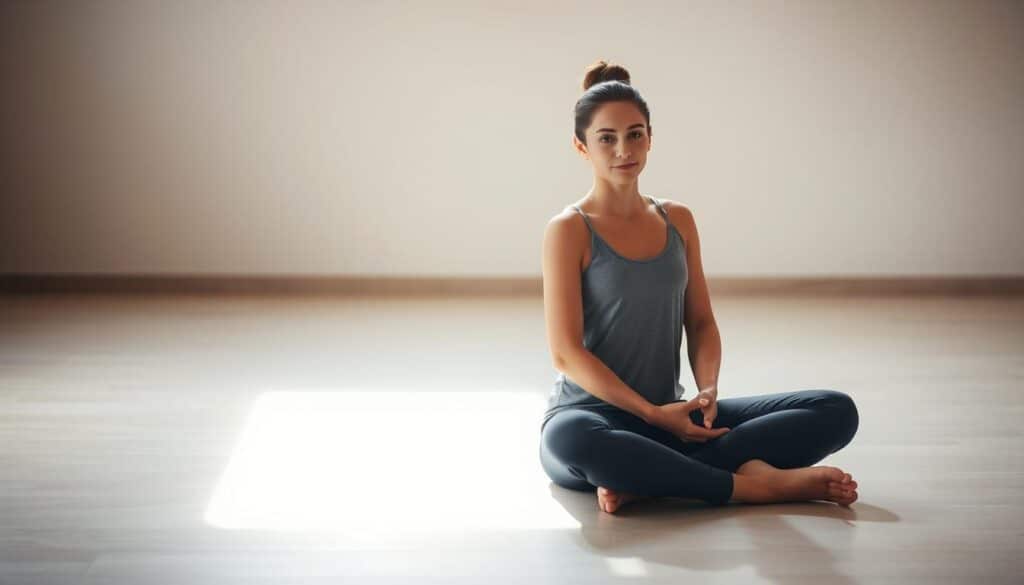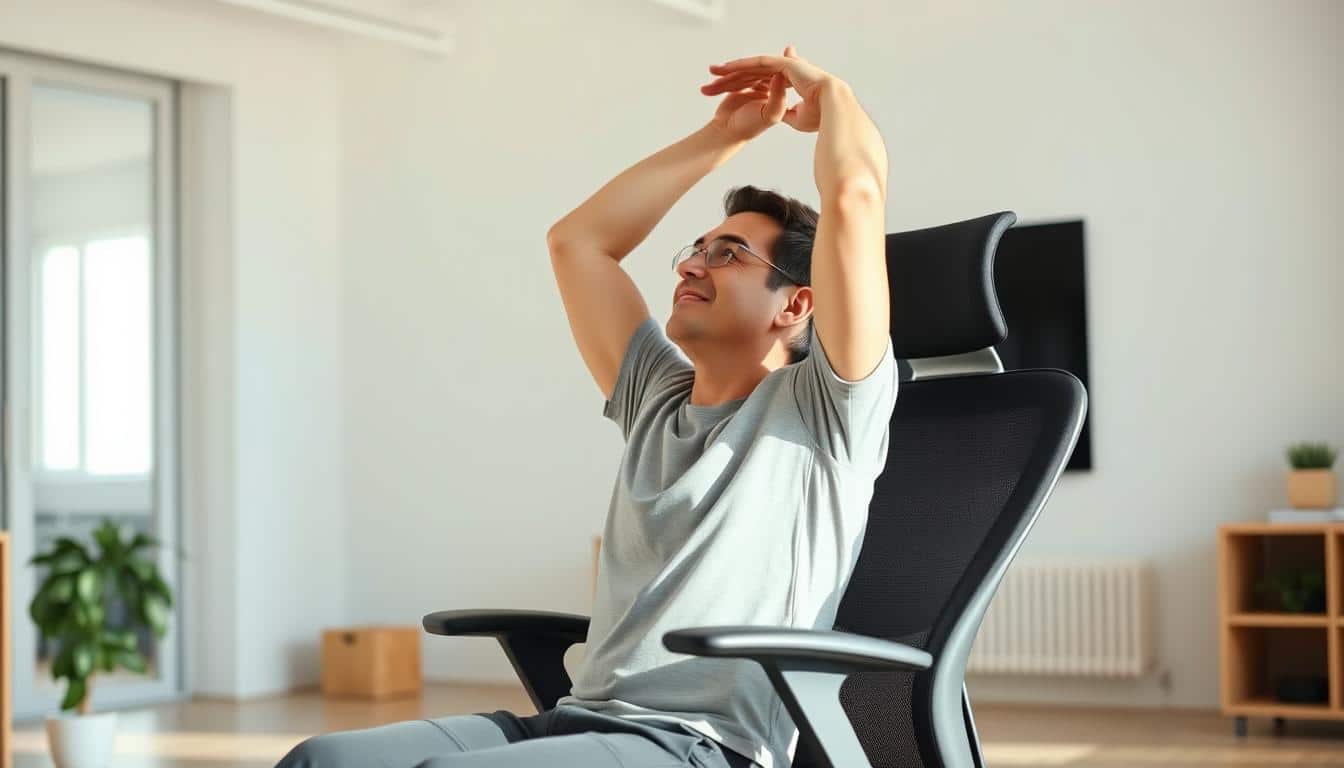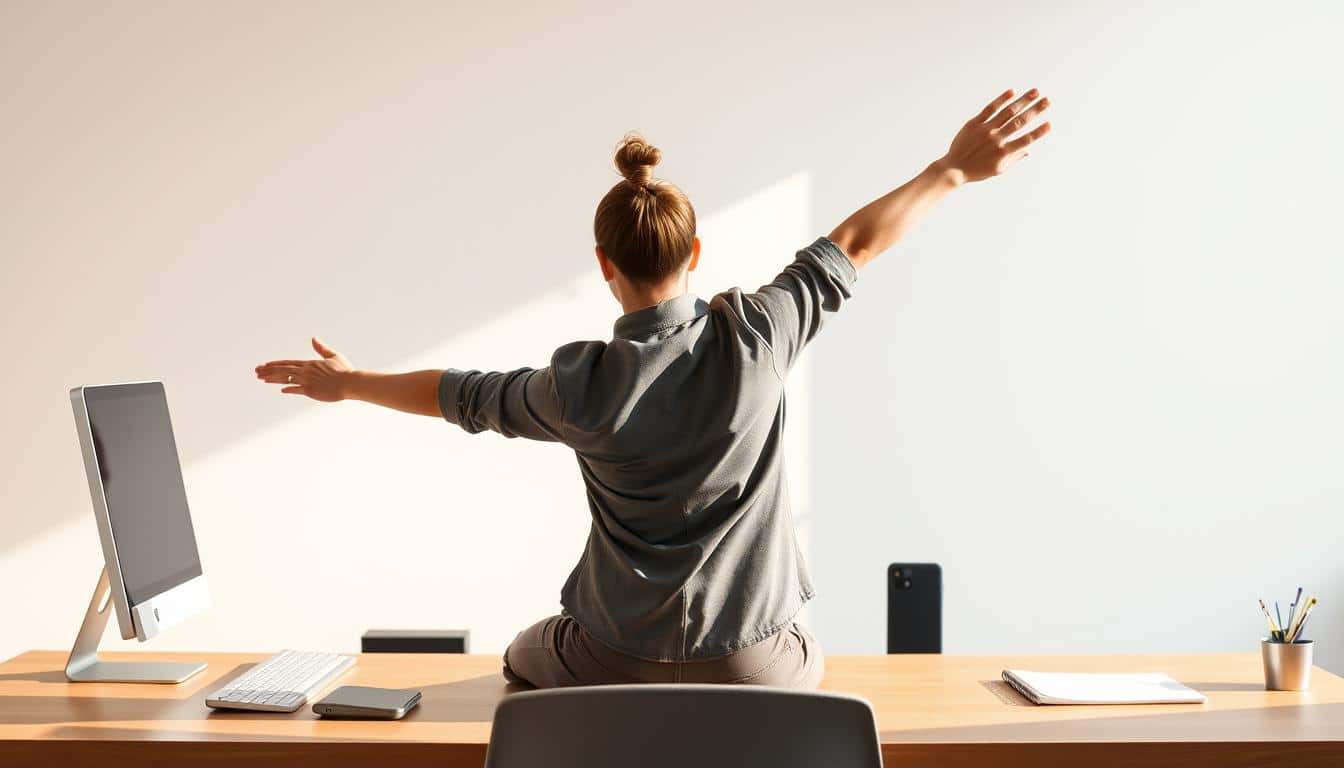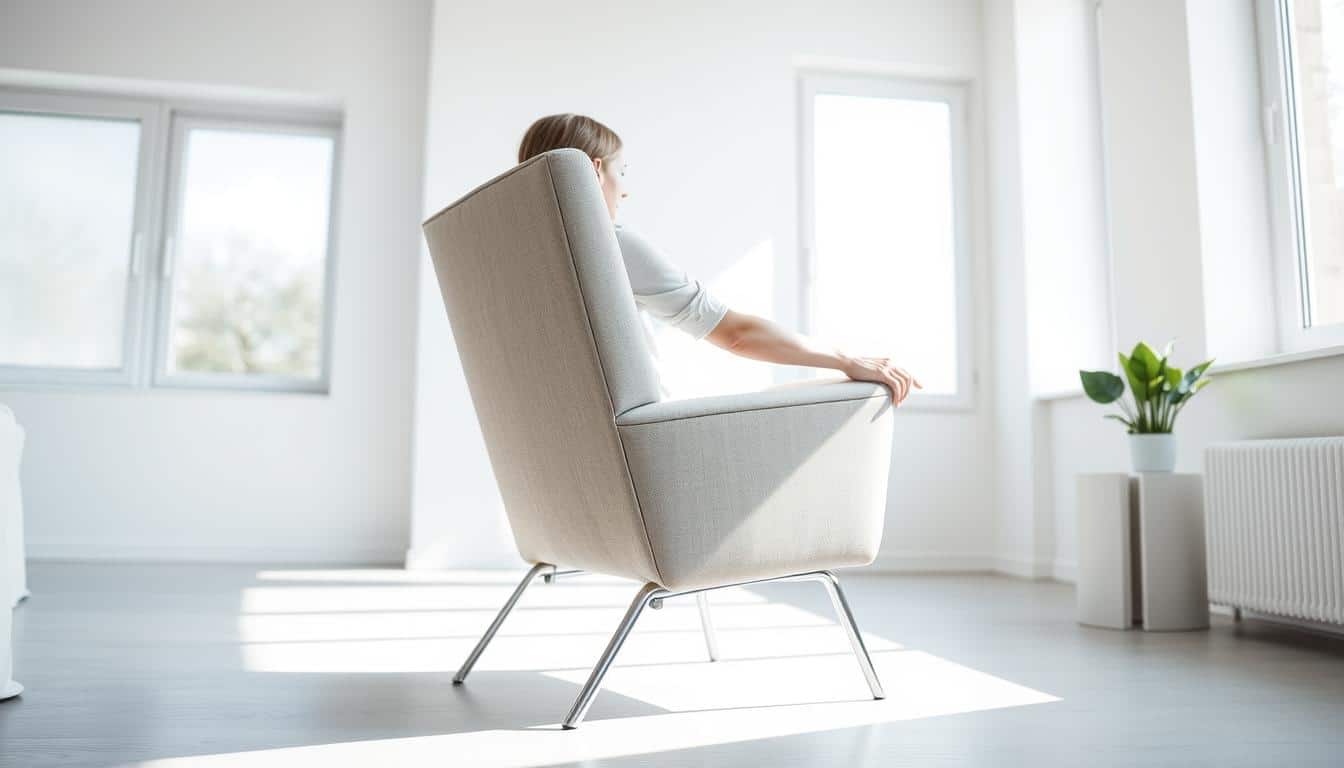Anúncios
This short guide introduces practical, evidence-informed seated stretching exercises designed for busy adults across the United States. If you spend long hours at a desk or want gentle movement you can do anywhere, this article gives clear routines and safety tips to boost flexibility, reduce tension, and protect joint health.
Anúncios
Our focus is on simple stretching exercises you can do while seated. You will find easy chair stretches, stretches while seated for neck, spine, legs, and wrists, plus a compact seated mobility routine to fit into mornings, lunch breaks, or evenings.
Recommendations are aligned with guidance from the American College of Sports Medicine (ACSM) and the Centers for Disease Control and Prevention (CDC), and reflect common clinical advice for desk workers and older adults who need gentle mobility work.
The article is organized to help you quickly find what you need: why seated stretching matters, step-by-step exercises, short morning and lunchtime routines, modifications for seniors and limited mobility, breathing and relaxation tips, and recommended props and apps to enhance practice.
Key Takeaways
- Seated stretching exercises make movement easy for busy adults and desk workers.
- Chair stretches and stretches while seated can reduce tension and improve range of motion.
- Short seated flexibility exercises fit into mornings, breaks, or evening wind-downs.
- Guidance follows ACSM and CDC recommendations for safe, regular mobility work.
- The article includes routines, safety tips, modifications, and recommended gear and apps.
Why Seated Stretching Matters for Busy Lives
Short, regular seated stretches offer real gains for people with tight schedules. They fit into workdays, commutes, and quick breaks. These moves boost circulation, ease tight muscles, and help maintain desk worker mobility without needing a gym or extra time.
Below are focused points that explain the main health effects, practical ways to add stretches to your day, and who gains the most from these habits.
Health benefits of seated stretches
Seated stretching improves joint range of motion and muscle flexibility. Regular gentle stretches reduce stiffness and lower muscle tension in the neck, shoulders, and lower back.
These moves promote circulation and help prevent venous pooling tied to long periods of sitting. Brief movement breaks can improve alertness and metabolic markers, supporting overall wellness.
When paired with mindful breathing, seated stretching can calm the nervous system and lower stress, aiding mental well-being.
How seated stretching fits into a daily routine
Micro-routines of one to five minutes work best for busy people. Try anchors like morning coffee, post-lunch, or the end of a long call to make stretches habitual.
Set calendar reminders or quiet phone alerts to prompt short breaks. Aim for steady consistency rather than pushing intensity; small daily efforts produce cumulative gains.
Who can benefit from seated stretching
Office workers and remote employees gain clear advantages from these low-effort practices. Drivers, caregivers, older adults, and people with limited mobility can also improve comfort and function.
Those returning from minor injuries may benefit after getting clearance from a healthcare professional. People with acute injuries, uncontrolled medical conditions, or recent surgery should consult a provider before starting new stretches.
Simple stretching exercises you can do while seated
Short breaks with targeted moves ease tension and boost focus. Use these quick options at your desk, in a meeting, or during a commute. Breathe slowly and work only in a pain-free range.
Neck and upper shoulder stretches
Try seated neck tilts: drop your ear toward one shoulder and hold 15–30 seconds. Repeat on the opposite side. Add a chin tuck to ease forward-head posture.
Reach one hand over your head to the opposite ear for an upper trapezius stretch. Perform gentle neck rotations while keeping movements slow. Finish with shoulder rolls and across-chest arm stretches to release the posterior shoulder.
Spine mobility and gentle twists
Start with seated cat-cow: tilt the pelvis forward and back to flex and extend the spine. Keep your feet grounded and move with your breath.
For seated spine twists, rotate from the thoracic area while keeping hips square. Use the chair back or an armrest for light leverage. Try chair-supported side bends to mobilize the lateral trunk muscles.
Maintain a neutral pelvis and avoid forced rotation if you have disc issues. These seated spine twists protect the lower back while improving mobility.
Hamstring and calf stretches from a chair
For a chair hamstring stretch, extend one leg with the heel on the floor or a low step. Hinge at the hip and keep the spine long, holding 20–30 seconds. Repeat on the other side.
Choose an active option like straight-leg raises with a slight knee bend to engage hip flexors and hamstrings. For calves, place toes on the floor with heel down and lean forward, or press toes against a wall or desk and push the knee forward.
Increase intensity slowly. If hamstrings feel very tight, shorten the range to avoid overstretching.
Wrist and forearm stretches for desk workers
Perform wrist flexor and extensor stretches by extending the arm and using the opposite hand to gently bend the wrist. Hold each direction for 15–30 seconds.
Include nerve glides such as median nerve flossing and finger spread and extension exercises to relieve repetitive strain. Add these wrist stretches at desk during micro-breaks every 30–60 minutes to lower the risk of tendonitis and carpal tunnel symptoms.
These simple stretching exercises you can do while seated fit into short breaks and build resilience over time. Pick two or three moves and repeat them through the day for steady relief.
Quick morning chair routine to wake your body
Start with a short introduction to energize your morning. This fast sequence fits into tight schedules and offers a gentle way to move after sleep. Use a sturdy chair and sit tall. A morning chair routine like this eases stiffness and primes the body for the day.
Try a set of three-minute chair stretches to boost circulation and mobility. Move slowly and listen to your body. Coordinate each motion with breath: open on the inhale, fold on the exhale. That cue helps you get the most from a seated wake-up routine.
Three-minute sequence to improve circulation
Perform each move for about 30 seconds. Start with seated cat-cow to mobilize the spine. Follow with neck rolls and gentle shoulder rolls. Do a seated hamstring stretch on the right, then the left. Add calf pumps to wake the ankles. Sit tall and twist gently to each side. Finish with deep diaphragmatic breaths.
Pacing and simple cues
Move at a relaxed tempo. Inhale to open the chest and lengthen. Exhale to fold and soften. This rhythm raises heart rate minimally and increases blood flow to muscles. The routine reduces morning stiffness while staying brief enough for busy mornings.
Modifications for limited mobility
If balance is a concern, use back support and smaller ranges of motion. Swap larger moves for isometric activations such as seated marches or ankle pumps. Lying down can feel easier when transitioning from bed. A cushion raises seat height to ease hip flexion. A footstool helps when stretching calves.
Breathing tips to enhance the routine
Use diaphragmatic breathing: inhale through the nose and expand the belly, exhale slowly through the mouth. Try a 3–4 second inhale with a 4–6 second exhale to calm the nervous system. Focus on tight areas and breathe into them to encourage release.
Repeat this morning chair routine daily to build habit. Even when rushed, three-minute chair stretches and mindful seated breathing for stretches offer a quick reset. Regular practice improves circulation, reduces stiffness, and helps you feel more present before the day begins.
Lunchtime chair stretches to reduce workday tension
Short breaks at midday can reset your body and clear your mind. A five- to ten-minute lunchtime chair stretches routine eases tight shoulders, opens the chest and reduces neck strain from screen time.
Office-friendly moves you can do at your desk
Start with a seated spinal twist. Sit tall, place one hand on the opposite knee and turn gently. Add shoulder blade squeezes to counter rounded shoulders. Interlace fingers behind your lower back and lift slightly for a chest opener. Extend one leg, hinge at the hips and reach toward the toes for a seated hamstring stretch.
Finish with neck release and wrist stretches. Drop the ear to the shoulder and hold. Extend each wrist and gently press to ease tension. These desk stretches fit into an email break or a quick walk to the printer.
Stretching discreetly during breaks
Choose slow, modest movements to stay low-profile. Use headphones if you prefer privacy. If a standing area is available, take a moment to stand and do a few deeper reaches.
Micro-breaks every 30–60 minutes work best. Two or three simple 1–3 minute breaks reduce fatigue and boost focus. Short pauses to stretch at work improve energy and cut down on discomfort.
Combining stretches with posture checks
Pair each stretch with a quick posture reset. Sit tall, feet flat, shoulders relaxed and chin slightly tucked. Hold that alignment while doing a chest opener or a spinal twist to reinforce correct posture.
Use ergonomic cues like monitor height and lumbar support to back up your efforts. Make a habit: every time you stand to refill water or visit the restroom, do a posture reset and one seated stretch. Over time, these small moves become lasting office-friendly chair exercises that help prevent upper crossed syndrome and repetitive strain.
Seated stretches for lower back relief
Lower back discomfort often builds from long hours of sitting. Gentle moves you can do at your desk help ease tension and improve mobility. Below are practical tips and safe options to try during short breaks.
Gentle lumbar stretches and supports
Try pelvic tilts while seated to mobilize the lower lumbar and cut stiffness. Sit tall, engage your core lightly and tilt the pelvis forward and back through small ranges. This form of seated lower back stretches wakes the muscles without strain.
For a deeper release, use a seated knee-to-chest alternative. Lift one knee toward your chest and hold the shin or knee for 15–30 seconds. That motion targets glutes and lower back while remaining chair-friendly.
Support the spine with a lumbar roll, a rolled towel, or your chair’s built-in lumbar support. Keeping a neutral spine makes lumbar chair stretches safer and more effective. Apply heat or gentle mobility before stretching if a clinician has recommended it.
How to avoid common mistakes that worsen pain
Avoid aggressive forward bending from the lower back. Hinge at the hips and keep the spine neutral to protect discs and ligaments. Controlled hip movement reduces unsafe loading.
Keep breathing steady during chair exercises for back pain. Holding your breath or using jerky moves raises tension. Move slowly and stop when sharp pain appears.
Distinguish between tension and acute pain. Do not push into sharp sensations. Back off when pain increases and try a gentler variation of the lumbar chair stretches you were using.
When to consult a professional
Seek medical or physical therapy evaluation for new, sharp, radiating pain, numbness, or weakness. Those signs may need targeted assessment and treatment beyond simple seated lower back stretches.
Physical therapists at clinics such as Mayo Clinic or Cleveland Clinic often prescribe specific mobility and stabilization programs. Techniques like McKenzie assessments or motor control work can guide safe progression of chair exercises for back pain.
Contact primary care urgently if you have fever, unexplained weight loss, or bowel or bladder changes. Those red flags require prompt evaluation rather than home stretching.
| Move | Purpose | How to do it |
|---|---|---|
| Seated pelvic tilt | Mobilize lower lumbar, reduce stiffness | Sit tall, hands on hips, tilt pelvis forward and back in small controlled motions for 8–12 reps |
| Seated knee-to-chest (alternate) | Stretch glutes and lower back | Lift one knee, hold shin, draw knee toward chest for 15–30 seconds, repeat 2–3 times per side |
| Lumbar support placement | Maintain neutral spine during sitting and stretches | Place a lumbar roll or towel at small of back; sit so support fills lumbar curve |
| Hip hinge from chair | Teach hip movement, protect the lower back | Move torso forward by bending at hips, keep spine neutral and knees slightly apart; use hands on thighs for guidance |
Stretching to improve flexibility and posture

Daily seated stretching can change how your body moves and feels. Short, focused sessions ease tightness and teach better alignment. Use gentle progress and simple tracking to keep momentum and stay motivated.
Long-term flexibility gains from daily seated stretches
Five to ten minutes of targeted work each day yields measurable change over weeks. Regularity matters more than intensity for connective tissue. Aim for slow increases in hold time and range to support long-term flexibility gains.
Combine gentle stretches with light strengthening so gains last. Expect gradual improvement; connective tissue adapts slower than muscle. Be patient and cautious to reduce injury risk and improve functional movement.
Posture-focused exercises to combat slouching
Scapular retractions and chin tucks restore neutral alignment. Try seated rows with a resistance band and thoracic extension over the chair back to open the chest. These posture exercises chair moves strengthen the muscles that hold you upright.
Set hourly reminders to reset posture and do 30-second scapular squeezes. Adjust seat height and monitor level for ergonomic support. Stretching helps, but real change comes from pairing exercises with better workspace setup.
Tracking progress and setting realistic goals
Pick clear, measurable targets: sit without slouching for 30 minutes or reduce morning stiffness by a few minutes. Use simple logs, photos, or apps to track stretching progress every two to four weeks.
Celebrate small wins and adjust goals as comfort improves. If you feel persistent pain, seek guidance from a clinician to refine technique and timelines for safer, lasting results.
Safety tips and modifications for different fitness levels
Start with a few basic safety tips before you begin any chair routine. Pay attention to seated stretch safety so you protect joints and reduce risk. Keep movements slow and controlled. Stop if a motion causes sharp pain.
How to adapt stretches for injury or chronic conditions
When you have osteoarthritis, reduce range of motion and try shorter, more frequent holds. Focus on joint-friendly ranges and low-impact mobility. For osteoporosis, avoid deep spinal flexion and forceful twists. Choose supported extension and small controlled movements after consulting your clinician.
With chronic pain or a recent injury, keep movements pain-free. Use graded exposure and pacing strategies that a physical therapist would recommend. Modify chair stretches so you can build tolerance slowly without flaring symptoms.
Using props: cushions, resistance bands, and straps
Simple props make many moves safer and more accessible. A firm cushion or a rolled towel behind the lower back gives lumbar support and adds seat height. Use it under the knee during hamstring work for better alignment.
Resistance bands from Amazon, Target, or Walmart work well for gentle assisted hamstring stretches and to strengthen the posterior chain. A yoga strap or belt helps you hold a foot or extend your reach without rounding the back. Place a non-slip mat under your feet for stability during seated leg lifts.
Choose affordable brands such as Fit Simplify resistance bands or Gaiam yoga straps for reliable, low-cost options that appear at major retailers.
Signs you should stop or modify a stretch
Know the warning signs so you can protect yourself. Stop immediately if you feel sharp, shooting, or radiating pain. Numbness, tingling, or sudden increase in joint swelling are red flags that need attention.
If you experience dizziness, nausea, or breathing difficulty during a stretch, cease activity and seek medical evaluation if symptoms persist. If symptoms worsen after stretching or do not settle, consult your primary care physician or a physical therapist for an assessment.
| Concern | Practical modification | Recommended prop |
|---|---|---|
| Low back pain | Use smaller range, support lumbar with cushion, avoid forward folding | Rolled towel or firm cushion |
| Hamstring tightness | Perform gentle band-assisted stretches, bend supporting knee slightly | Resistance band (Fit Simplify) |
| Limited reach | Use a strap to bridge gap, keep spine long and avoid twisting | Yoga strap or belt (Gaiam) |
| Osteoporosis | Favor supported extension, avoid deep flexion and forceful twists | Chair with back support and cushion |
| Chronic pain or recent injury | Prioritize pain-free movements, use graded exposure and pacing | Light resistance band and cushion for comfort |
Seated stretching routines for seniors and limited mobility
Gentle, consistent movement keeps bodies active and minds engaged. Short sessions work best for many older adults. These adaptive seated routines focus on safety, easy progressions, and building confidence with each repetition.
Gentle sequences tailored for older adults
Start with ankle pumps, seated marches, and gentle hip and knee range-of-motion moves. Add seated chest openers and neck and shoulder mobility to reduce stiffness. Hold each stretch for comfortable counts and move at a slow tempo.
Keep sessions brief, five to ten minutes, done daily or several times a day. Use a firm chair with armrests, wear non-slip footwear, and clear the space around the chair before standing. These steps lower fall risk when transitioning from sitting to standing.
Building confidence and independence through movement
Begin with caregiver or therapist supervision until the person feels steady. Then progress to independent practice with scheduled reminders or gentle timers. Tracking small wins helps. Note easier transfers, less morning stiffness, or improved walking distance.
Regular chair exercises for limited mobility boost mood and autonomy. Positive feedback and clear goals help maintain motivation. Over time, elderly chair stretches fast become part of daily life and support independence in routine tasks.
Working with caregivers and physical therapists
Caregivers can cue movements, offer stable support, and ensure proper alignment. Training resources from local senior centers and the American Physical Therapy Association help caregivers learn safe techniques. Community programs at YMCAs and hospitals often offer guided group sessions.
Physical therapists design individualized plans that combine balance, strength, and flexibility. They advise on safe progressions and flag contraindicated moves. When in doubt, consult a licensed therapist before increasing intensity of adaptive seated routines.
Incorporating mindful breathing and relaxation

Pairing breath with gentle movement makes seated stretches richer and more calming. Start each stretch with a slow inhalation to expand the belly, then exhale fully as you move into the pose. This approach supports mindful breathing stretches and helps release tension safely.
Breathing techniques to deepen stretches
Use diaphragmatic breathing: inhale to fill the belly, then exhale to soften muscles and deepen range. Try box breathing on breaks with a 4-4-4-4 rhythm to steady the mind before a session.
Focus on exhaling during the active phase of a stretch. For example, exhale as you hinge forward or twist to increase comfort and control. These breathing techniques for stretching reduce strain and improve stretch tolerance.
Simple relaxation practices to pair with seated stretches
Progressive muscle relaxation adapts well to chairs. Tense a group for a few seconds, then release while maintaining slow breaths. Follow with a brief body scan from head to toe to spot tight areas.
Use short mindfulness prompts: notice sensations without judgment and return attention to breath and posture. These steps deepen relaxation with chair stretches and quiet the nervous system.
Short guided routines for stress reduction
Try a 3–7 minute sequence: slow neck rolls, shoulder openers, two rounds of diaphragmatic breaths, and seated side-bends. Keep movements small and steady while coordinating inhale and exhale.
Explore apps such as Headspace, Calm, or Insight Timer for brief sessions that match busy schedules. Those guided seated routines pair breath and movement to lower cortisol and sharpen focus.
Tools and gear to enhance seated stretching sessions
Picking the right gear makes seated stretches safer and more effective. A sturdy, armless chair with a flat seat and firm back helps you keep balance and maintain a neutral spine. Adjustable office chairs work well when you need to set hips slightly higher than knees for better alignment.
Avoid soft couches or sinking seats that force you to slouch. If you need extra support, add a lumbar roll or small cushion to keep the lower back supported. When choosing a chair for seated stretching, look for a stable base and a seat that lets your feet remain flat on the floor.
Small, affordable accessories expand your range safely. A yoga strap or belt helps with hamstring and calf work when flexibility is limited. Light to medium resistance bands add gentle strength training and assist with deeper holds. Non-slip foot wedges and low steps are handy for calf stretches and heel raises.
Brands like AmazonBasics, Gaiam, and SPRI offer budget-friendly options you can buy at Target or Walmart. For progressive conditioning, ankle weights are useful if used cautiously. Pack these stretching accessories in a small bag for easy access at work or while traveling.
Follow quality instruction to get the most from your sessions. Many instructors post short chair-friendly routines on YouTube, where channels focused on desk-friendly exercises or senior fitness can guide you. Yoga With Adriene has gentle options suited to beginners and mixed-ability classes.
Try apps for structure and consistency. FitOn and Daily Yoga provide guided programs, while SilverSneakers targets older adults with safe progressions. When selecting content, favor certified instructors with ACE, NASM, or accredited yoga credentials and clear modification cues.
Bookmark a few reliable videos or save favorite sessions in an app to turn practice into habit. Using stretching apps and curated playlists reduces decision fatigue and makes it easier to stretch daily, even on busy workdays.
Conclusion
This seated stretching summary wraps up the key points: chair-based moves are accessible, time-efficient, and effective for easing tension. Simple routines — like the neck, spine, and calf stretches described earlier — fit into busy mornings or short lunch breaks and can boost flexibility and posture when done regularly.
If you want to start chair stretches, aim for 1–10 minutes a day and pick one short routine from the article. Try the three-minute morning sequence or a discreet lunchtime set. Use apps or YouTube videos to follow along and consider low-cost props such as a lumbar roll or resistance band to deepen results.
Prioritize safety as you try simple stretching exercises you can do while seated. Modify movements for injuries, stop for sharp pain, and consult a healthcare professional when needed. With brief, consistent practice you can reduce stiffness, improve posture, and make movement a reliable part of your day.
FAQ
What are some simple stretching exercises you can do while seated?
How often should I do seated stretches to see benefits?
Are seated stretches safe for older adults or people with limited mobility?
What precautions should I take if I have lower back pain?
Can seated stretching help with posture and neck or shoulder tension from desk work?
How do I pair breathing with stretches to get better results?
What props or gear are helpful for seated stretching sessions?
How can I make a short morning chair routine that wakes my body?
What are discreet stretches I can do at my desk during lunch?
When should I stop a stretch and seek medical advice?
Can seated stretches improve long‑term flexibility?
Are there modifications for common conditions like osteoarthritis or osteoporosis?
What apps or videos are good for guided seated stretching routines?
How can caregivers or therapists support seniors learning seated stretches?
How do I track progress and set realistic goals for flexibility and posture?
Content created with the help of Artificial Intelligence.



